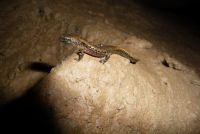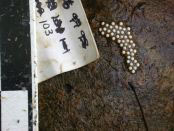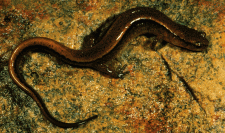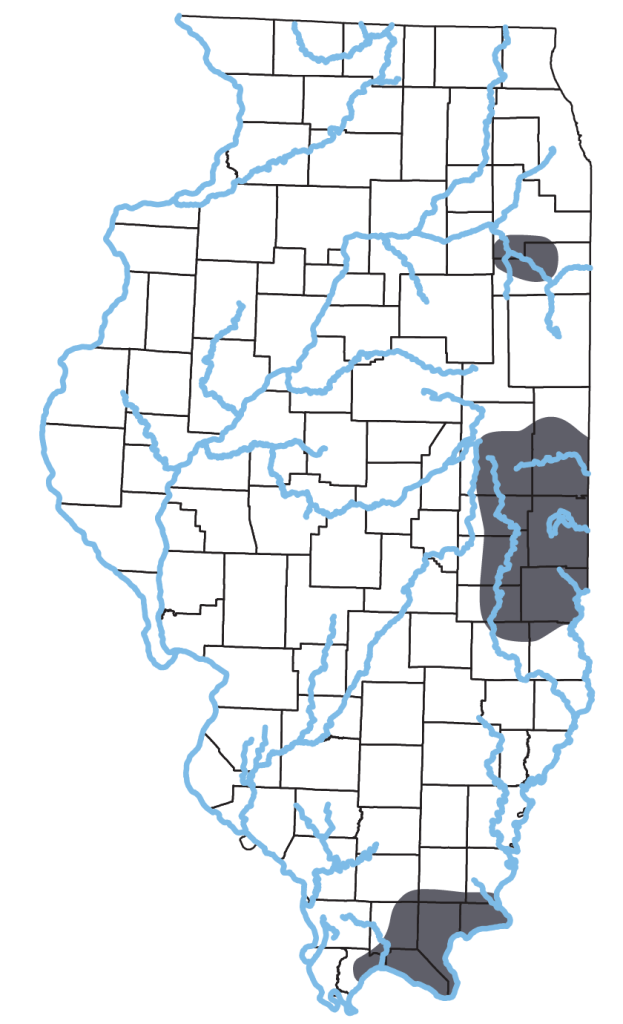Eurycea cirrigera (Green, 1830)

Key Characters: Slender yellow or tan body with two dark stripes down back from eyes onto tail.
Similar Species: Cave Salamander, Long-tailed Salamander, Dusky Salamander. See Key to Adult and Larval Salamanders of Illinois for help with identification.
Subspecies: Formerly three subspecies were recognized; Eastern Northern Two-lined salamander, E. b. bislineata; Southern Two-lined Salamander, E. b. cirrigera, and Blue Ridge Two-lined salamander, E. b. wilderae. All three are now recognized as full species. See “Nomenclatural History,” below.

Description: A small (up to 11 cm TL), slender salamander with small black spots between the dark back stripes and on top of head. Belly unspotted yellow. Tail 61% of TL or less and legs short. Costal grooves distinct. Nasolabial grooves present and, in breeding male, continue onto elongated cirri on upper lip. Three or more costal folds between adpressed limbs. Larva slender, with low tail fin and long gill rami, unpigmented throat, and marked on the back with paired light spots that sometimes fuse with narrow midback pale stripe.
Habitat: Near rocky brooks, spring seeps, and spring-fed streams in mesic forests.
Natural History: Adults can be found along edge, larvae in pools. They eat worms and other small invertebrates. At night during rain, adults and juveniles wander into woods as they feed. Slippery and agile, they escape by quickly swimming, jumping, or running to cover. From April to May, females attach white eggs, individually in tight clusters, to undersides of rocks (see image, above right) that are exposed to running water. Larvae probably transform during second year of life. See Jakubanis et al. (2008, Northeastern Nat. 15(1):131–140) for information on the ecology of E. cirrigera in Illinois..

Status: Locally abundant in spring and autumn. Western edge of range ends along the Kankakee River, eastern edge of the Grand Prairie, and in the eastern Shawnee and Cretaceous Hills.
Etymology: Eurycea – possibly a mythological reference to Eurydice, wife of Orpheus; cirrigera – cirrus (Latin) for curl, ringlet, tendril; gera (Latin) for bear, carry, perform.
Original Description: Green, J. 1830. Descriptions of two new species of salamanders. Journal of the Academy of Natural Sciences, Philadelphia. 6:253-254.
Type Specimen: 4 syntypes, now lost. Green did not state where he deposited the syntypes, but it is reasonable to assume they went to ANSP; According to Cope (1889, Bull. U.S. Natl. Mus., 34: 165, 168), USNM 4734 (only 2 specimens) from “Southern States (La.?)” are Green’s types, but these are now lost (Dunn, 1926, Salamanders of the Family Plethodontidae, p. 307).
Type Locality: “near New Orleans”
Original Name: Salamandra cirrigera Green, 1830
Nomenclatural History: Originally named as a full species, E. cirrigera was reduced to a subspecies of E. bislineata by W.H. Smith (1877, The Tailed Amphibians, Including the Caecilians. A Thesis Presented to the Faculty of Michigan University). Dunn (1920, Proc. Biol. Soc. Washington, 33: 135) agreed, but Jacobs (1987, Herpetologica, 43: 423-446) showed, using protein electrophoresis that the three formerly recognized subspecies of E. bislineata (E. b. bislineata, E. b. cirrigera, and E. b. wilderae) were distinct enough to warrant species status.


